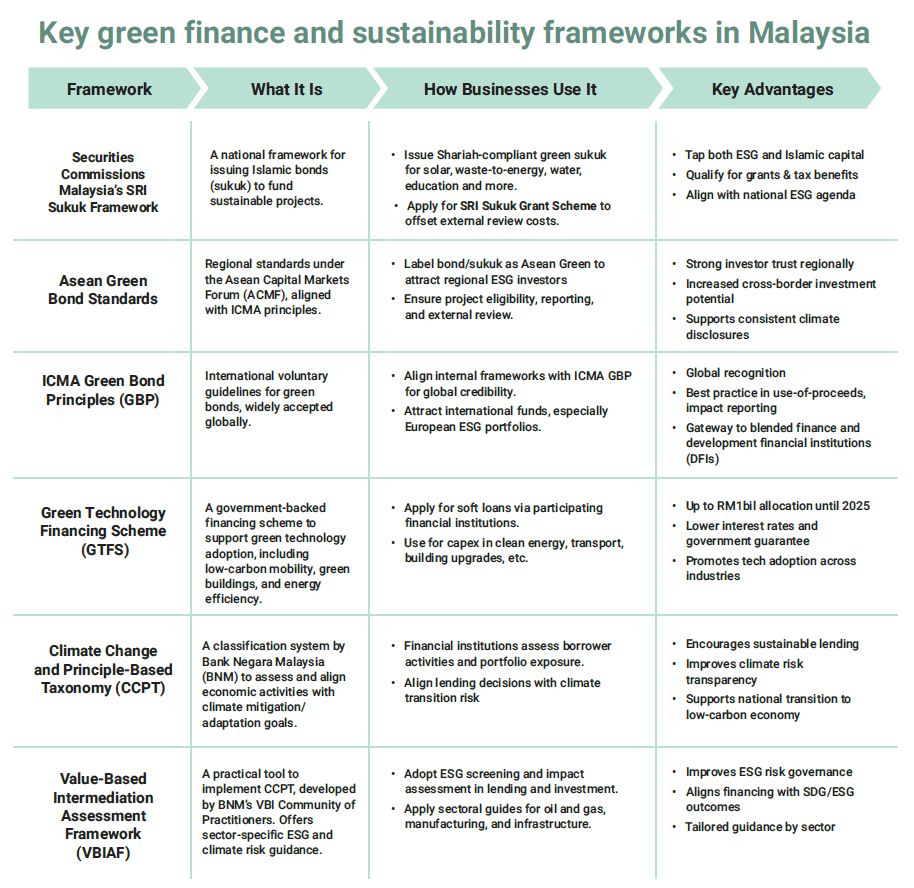
BIX ARTICLE
Bankable sustainability
Jul 25, 2025
|
8 min read
Featured Posts
Social Bonds Illustrative Use-Of-Proceeds Case Studies Coronavirus
Jul 06, 2020
|
2 min read
Sustainable Banking Network (SBN) Creating Green Bond Markets
Jul 06, 2020
|
2 min read
Why is Inflation Making a Big Comeback After Being Absent for Decades in the U.S.?
Mar 24, 2022
|
7 min read
SC issues Corporate Governance Strategic Priorities 2021-2023
Mar 29, 2022
|
3 min read

PALM oil giants, solar startups, data centre developers and more operate in vastly different industries. Yet, besides revenue growth, earnings and returns, they are all chasing another thing in common—green capital.
Green capital refers to funding dedicated to projects or companies that generate measurable environmental benefits, such as renewable energy or sustainable agriculture. This capital is often channeled through instruments like green bonds or sustainability-linked sukuk, which link financing to ESG performance.
These companies aren’t the only ones. From pioneering the world’s first green sukuk to seeing bonds oversubscribed by sustainability-hungry investors, more and more companies are discovering that in today’s economy, chasing green is ethical and good business.
But there is a catch. Sustainability is not bankable unless it is credible, structured and certified. That is why companies are moving towards aligning with global standards like the International Capital Market Association (ICMA) Green Bond Principles and the Asean Green Bond Standards to polish their ESG credentials and open doors to new pools of capital.
Green bonds and ESG-linked sukuk are debt instruments designed to raise funds specifically for projects with environmental and social benefits. Unlike conventional bonds, their terms often include commitments to achieve defined ESG targets, making them appealing to investors seeking both financial returns and measurable impact.
A financial enabler
It was not long ago when Malaysian corporations viewed ESG as a reporting obligation and tedious checklist. That narrative has shifted since then.
Today, ESG has become a strategic lever for accessing capital, managing risk and signaling long-term value to investors.
Bank Negara Malaysia (BNM) Governor Datuk Seri Abdul Rasheed Ghaffour said the central bank has found there has been uptake in green and transition related financing and solutions.
“Financial institutions are increasing their offering of green and transition related financing and solutions. These point towards the financial sector making steady progress in supporting Malaysia’s orderly transition to a greener economy.
“On green financing, we see growing demand and uptake of funds made under BNM’s Low Carbon Transition Facility and High Tech and Green Facility. Similarly, we saw further progress in the Greening Value Chain programme with over 150 SMEs having begun reporting emissions data,” he said in his foreword of the BNM Annual Report 2024.
Meanwhile, according to the International Finance Corporation (IFC)—the largest global development institution focused on the private sector in emerging markets and a member of the World Bank Group—ESG integration in emerging markets is increasingly driven by the demand of international investors and access to global capital markets—not purely by regulation.
In IFC’s Emerging Market Green Bonds 2023-2024 Report, it was stated that this shift is particularly visible in Malaysia, where more corporates are using ESG-linked tools such as green bonds, sustainability-linked sukuk, and ESG-themed funds to unlock capital.
Companies with credible sustainability frameworks can tap into larger and more diverse pools of investors—many of whom are actively reallocating capital toward climate-positive and socially responsible investments, it noted.
Insights from the Climate Bonds Initiative’s Asean Sustainable Finance State of the Market 2022 show that Asean countries are intensifying their positioning for green and sustainable finance, which is gaining traction with the private sector.
It was noted that nearly half of Malaysian companies surveyed are investing in new technologies and upskilling to protect their future business, a sign of corporate action beyond public sector mandates.

What is driving the demand?
ESG-linked instruments are increasingly valued for ethical reasons as well as their ability to deliver climate resilience, social impact, and sustainable long-term returns.
The Global Sustainable Investment Alliance’s Global Sustainable Investment Review 2023 points to investors’ growing insistence on clear disclosures and impact measurement, further driving demand for ESG-linked products that meet internationally recognised standards.
Meanwhile, over 80% of asset owners have integrated ESG factors into their investment decisions, driven by evolving client demands and tighter regulatory requirements, PwC’s Global ESG Survey 2023 found.
IFC’s Emerging Market Green Bonds 2023–2024 report highlights how robust regulatory frameworks, such as the Asean Green Bond Standards, underpin investor confidence by ensuring transparency and credibility.
Companies demonstrating strong ESG credentials benefit from lower capital costs and superior valuation, encouraging issuers to adopt ESG-linked financing, stated McKinsey’s The ESG Premium: New Perspectives on Value and Performance report.
Meanwhile, Deloitte has highlighted that sustainability-linked bonds (SLBs) have emerged as strategic financing instruments that align corporate sustainability goals with financial performance.
These bonds adjust interest rates based on whether issuers meet predefined ESG targets—creating a direct financial incentive for achieving sustainability outcomes.
Making ESG bankable
Investors today demand clear, verified impact metrics that demonstrate real progress on environmental, social, and governance goals.
Aligning with internationally recognised standards, such as the ICMA Green Bond Principles and the Asean Sustainability Taxonomy, is critical.
These frameworks guide issuers to set clear, time-bound sustainability KPIs—from emissions reduction targets to renewable energy usage—that resonate with global investors.
Credibility is key. According to Securities Commission Malaysia, obtaining third-party assurance for ESG disclosures enhances investor confidence and reduces perceived risks.
Firms like CIMB’s ESG advisory unit offer expert guidance to help corporations develop transparent, investor-aligned sustainability frameworks.
World Bank has emphasised that standardised, transparent ESG disclosures are essential to reducing issuance premiums and attracting cross-border investment.
It notes that credible sustainability reporting is critical for unlocking sustainable finance across sovereigns, corporates, and financial institutions.
Malaysian issuers leading the way
Malaysia has emerged as a pioneer in Asean’s sustainable finance space, with corporates actively issuing green bonds and sustainability-linked sukuk to fund low-carbon projects and future-proof their business models.
The country made global headlines in 2017 when Tadau Energy Sdn Bhd issued the world’s first green SRI sukuk to finance a solar photovoltaic plant in Sabah.
Since then, a growing number of issuers—including Quantum Solar Park, PNB Merdeka Ventures, UiTM Solar Power and Sinar Kamiri—have followed suit, funding solar farms, green buildings, and hydropower projects.
YTL Power International Bhd issued a RM1.5bil sustainability-linked sukuk, where interest rates are tied to achieving verified ESG targets.
CIMB Group Holdings Bhd has advised on numerous green and sustainability-linked instruments and developed one of the region’s most comprehensive sustainable finance frameworks.
Cagamas Bhd, the national mortgage corporation, has issued both green and social bonds, showcasing how ESG funding can be channeled into housing access and environmental impact.
More recently, companies have begun adopting outcome-based financing.
Yinson Holdings Bhd issued Malaysia’s first sustainability-linked sukuk in 2021, a RM1bil deal with coupon rates tied to achieving ESG targets.
Cenviro Sdn Bhd and Sunway REIT have also entered the market with performance-linked sukuk, signaling a shift toward ESG accountability.
Green projects by the billions
Malaysia is steadily positioning itself as a regional leader in sustainable infrastructure, driven by a surge of large-scale green investments aligned with national decarbonisation goals.
These projects, backed by both domestic conglomerates and global investors, are reshaping the country’s industrial and energy landscape. One of the most significant commitments to date is from Saudi Arabia’s ACWA Power, which signed a Memorandum of Understanding with the Malaysian Investment Development Authority (MIDA) in May 2025 to invest up to US$10bil in developing 12.5 gigawatts of renewable energy capacity by 2040.
Meanwhile, Khazanah Nasional Bhd, via UEM Group Bhd, is spearheading a RM6bil, 1 GW hybrid solar project with a 16.2ha renewable energy industrial park in Gerbang Nusajaya, Johor. Led by UEM Sunrise in partnership with ITRAMAS, CMECWUXI, and Blueleaf Energy (part of Macquarie’s Green Investment Group), the project supports Malaysia’s National Energy Transition Roadmap.
SD Guthrie Bhd, formerly known as Sime Darby Plantation Bhd, is building a 404.7ha industrial zone in Perak, with 267.1ha dedicated to solar generation under its net-zero roadmap.
YTL Power is also advancing a 500MW solar-powered data centre campus in Kulai, Johor—a project valued at over RM20bil in collaboration with NVIDIA.
Supporting these headline initiatives are waste-to-energy facilities in Selangor and Sarawak, alongside hydropower and floating solar projects. Still, it is essential to differentiate between green infrastructure and ESG-linked finance: The former delivers environmental outcomes, while the latter ties financial terms to measurable ESG performance targets.
A greener financial future
Looking ahead, green and ESG-linked finance is poised to reshape capital flows and corporate priorities. However, it is not without fault lines. Uneven disclosure standards, greenwashing, and a growing gap between ESG rhetoric and results threaten to erode trust.
While Malaysia makes strides, the market still grapples with questions of depth, integrity and real impact. Investors are watching but so are sceptics. As ESG becomes a powerful lever for raising capital, the line between genuine sustainability and opportunistic branding is blurring. The question remains—are ESG labels financing a better future or simply financing business as usual under a greener name?
Disclaimer
The information provided in this report is of a general nature and has been prepared for information purposes only. It is not intended to constitute research or as advice for any investor. The information in this report is not and should not be construed or considered as an offer, recommendation or solicitation for investments. Investors are advised to make their own independent evaluation of the information contained in this report, consider their own individual investment objectives, financial situation and particular needs and should seek appropriate personalised financial advice from a qualified professional to suit individual circumstances and risk profile. The information contained in this report is prepared from data believed to be correct and reliable at the time of issuance of this report. While every effort is made to ensure the information is up-to-date and correct, Bond and Sukuk Information Platform Sdn Bhd (“the Company”) does not make any guarantee, representation or warranty, express or implied, as to the adequacy, accuracy, completeness, reliability or fairness of any such information contained in this report and accordingly, neither the Company nor any of its affiliates nor its related persons shall not be liable in any manner whatsoever for any consequences (including but not limited to any direct, indirect or consequential losses, loss of profits and damages) of any reliance thereon or usage thereof.
YOU MAY ALSO LIKE
TUTORIAL
Dec 29, 2025
|
5 min read
ARTICLE
Dec 23, 2025
|
5 min read
ARTICLE
Dec 22, 2025
|
6 min read
ARTICLE
Dec 18, 2025
|
7 min read


